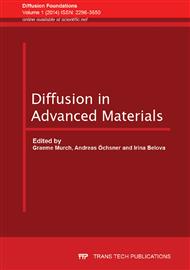[1]
D.J. Aidley and P.R. Stanfield, Ion Channels, Cambridge University Press, Cambridge (1996).
Google Scholar
[2]
J. -C. Olsen, K. E. Griffiths and J. F. Stoddart , A Short History of the Mechanical Bond, in From Non-Covalent Assemblies to Molecular Machines, J. -P. Sauvage, P. Gaspard (Eds. ), Wiley-VCH: Weinheim, Germany (2011), pp.67-139.
DOI: 10.1002/9783527632817.ch8
Google Scholar
[3]
see for example) B. Roux, B Prod'hom, M. Karplus, Biophys J. 68 p.876–892 (1995).
Google Scholar
[4]
S. Matile, A. Som and N. Sorde, Tetrahedron 60 6405-35 (2004); N. Sakai and S. Matile, Langmuir 29 9031-40 (2013); T.M. Fyles, Chem. Soc. Rev. 36 335-47 (2007); L. Echegoyen, Nature 369 276-7 (1994).
Google Scholar
[5]
I. Tabushi, Y. Kuroda and K. Yokota, Tetrahedron Lett. 23 4601-4 (1982)].
Google Scholar
[6]
M.R. Ghadiri, J.R. Granja and Lukas K. Buehler, Nature 369 301 (1994).
Google Scholar
[7]
G.A. Woolley and B. A Wallace, J. Membr. Biol. 129 109-136 (1992)].
Google Scholar
[8]
G.W. Gokel, R. Ferdani, J. Liu, R. Pajewski, H. Shabany and P. Uetrecht, Chem. -Eur. J. 7 33-39 (2001)].
DOI: 10.1002/1521-3765(20010105)7:1<33::aid-chem33>3.0.co;2-3
Google Scholar
[9]
D.A. Morton-Blake, Journal of Molecular Liquids 167, 57 (2012).
Google Scholar
[10]
W. Smith and T.R. Forester, J. Molec. Graphics 14 (1996) 136.
Google Scholar
[11]
Gaussian 03, Revision E. 01, M. J. Frisch, G. W. Trucks, H. B. Schlegel, G. E. Scuseria, M. A. Robb, J. R. Cheeseman, J. A. Montgomery, Jr., T. Vreven, K. N. Kudin, J. C. Burant, J. M. Millam, S. S. Iyengar, J. Tomasi, V. Barone, B. Mennucci, M. Cossi, G. Scalmani, N. Rega, G. A. Petersson, H. Nakatsuji, M. Hada, M. Ehara, K. Toyota, R. Fukuda, J. Hasegawa, M. Ishida, T. Nakajima, Y. Honda, O. Kitao, H. Nakai, M. Klene, X. Li, J. E. Knox, H. P. Hratchian, J. B. Cross, V. Bakken, C. Adamo, J. Jaramillo, R. Gomperts, R. E. Stratmann, O. Yazyev, A. J. Austin, R. Cammi, C. Pomelli, J. W. Ochterski, P. Y. Ayala, K. Morokuma, G. A. Voth, P. Salvador, J. J. Dannenberg, V. G. Zakrzewski, S. Dapprich, A. D. Daniels, M. C. Strain, O. Farkas, D. K. Malick, A. D. Rabuck, K. Raghavachari, J. B. Foresman, J. V. Ortiz, Q. Cui, A. G. Baboul, S. Clifford, J. Cioslowski, B. B. Stefanov, G. Liu, A. Liashenko, P. Piskorz, I. Komaromi, R. L. Martin, D. J. Fox, T. Keith, M. A. Al-Laham, C. Y. Peng, A. Nanayakkara, M. Challacombe, P. M. W. Gill, B. Johnson, W. Chen, M. W. Wong, C. Gonzalez, and J. A. Pople, Gaussian, Inc., Wallingford CT, (2004).
Google Scholar
[12]
J. Åqvist, J. Phys. Chem. 94 8021-8024 (1990).
Google Scholar
[13]
S.H. Lee and J.C. Rasaiah, J. Chem. Phys. 100 1420 (1996).
Google Scholar
[14]
S. L. Mayo, B. D. Olafson and W.A. Goddard III, J. Phys. Chem. 94 (1990) 8897-8909.
Google Scholar
[15]
H. J. C. Berendsen, J. R. Grigera, and T. P. Straatsma, J. Phys. Chem. 91 (1987), pp.6269-6271.
Google Scholar
[16]
D.A. Morton-Blake, Soft Matter 6 558 (2010).
Google Scholar
[17]
H.D. Young, R.A. Freedman, University Physics 11th ed., Pearson Addison Wesley, San Francisco (2004).
Google Scholar
[18]
D.A. Morton-Blake and Conan Kumari-Doyle, Computational and Theoretical Chemistry 1008 74 (2013).
Google Scholar
[19]
L. Singer, Friction and energy dissipation at the atomic scale: A review. J. Vac. Sci. Technol. A (1994) 12(5), Sep/Oct 2605-216; Fundamentals of Friction, edited by I. L. Singer and H. M. Pollock ~Kluwer, Dordrecht, (1992).
Google Scholar
[20]
E. Gnecco, R. Bennewitz, T. Gaylog, Ch. Loppacher, M. Bammerlin, E. Meyer, H. -J. Güntherodt, Physical Review Letters 84 1172 (2000).
DOI: 10.1103/physrevlett.84.1172
Google Scholar
[21]
I.M. Sivebaek, V.N. Samoilov, Bo.N. J. Persson, Langmuir 26 8721 (2010).
Google Scholar
[22]
P.T. Henderson, D. Jones, G. Hampikian, Y. Kan, G.B. Schuster, Proc. Natl. Academy of Sciences of the United States of America 96, 8353-8358 (1999).
DOI: 10.1073/pnas.96.15.8353
Google Scholar


